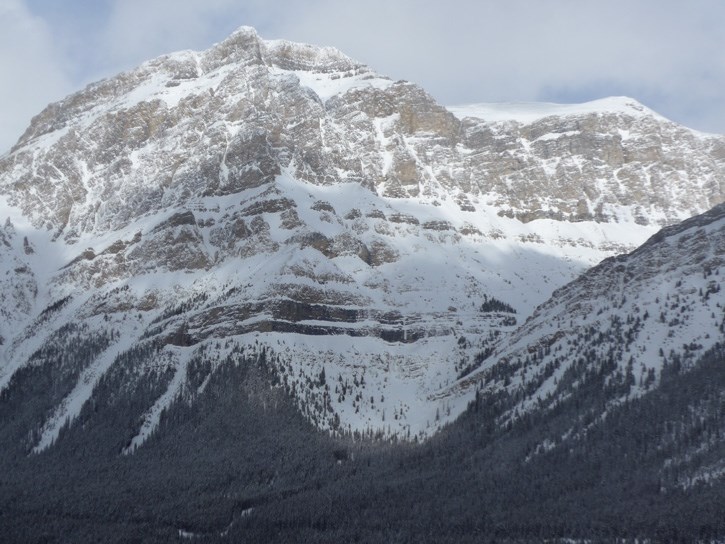An historic avalanche cycle, which led to the deaths of two American tourists who were out snowshoeing in Banff National Park last week, has prompted a warning for outdoor enthusiasts to keep out of avalanche terrain.
Massive natural slides ran everywhere throughout the national parks and Kananaskis Country this week and last, including a class 4 on Cascade Mountain near Banff and a class 3.5 that thundered across Lake Louise, breaking the ice on the famous lake.
“It’s been a crazy cycle. None of us in visitor safety have ever seen such large avalanches over such a widespread area,” said Grant Statham, a recognized avalanche expert and Parks Canada’s visitor safety specialist for Banff, Yoho and Kootenay.
“We would call it a 30-year avalanche cycle. That means the last time a lot of avalanches ran that far was probably about 30 years ago.”
As the historically large avalanche cycle tapers off, the avalanche danger is expected to be downgraded slightly from high to considerable by the weekend, with human-triggered avalanches a likely possibility.
“We believe we’ve seen the peak of this cycle, but we’re almost getting into a trickier time over the next few days and weekend,” said Statham, noting ski conditions are excellent and the forecast calls for a sunny, warmer weekend.
“I would exercise enormous caution. I think people should avoid avalanche terrain. I wouldn’t go near it. Any slope that has not avalanched is really suspect.”
Last Friday (March 17), Parks Canada public safety specialists recovered the bodies of a woman and man, both 32, from Boston, Mass. They were buried in a slide near Mount Hector along Highway 93 North, about a 20-minute drive north of Lake Louise.
The two visitors were reported missing from a hotel in Field, B.C. on Tuesday morning (March 14) when they did not check out, prompting an RCMP missing person investigation.
That eventually led to the pair’s rental car being located at the Mount Hector trailhead at about 3 p.m. that day. A park search and rescue team later saw tracks leading into the avalanche debris.
It’s believed the snowshoers were caught in the slide on Saturday or Sunday (March 11-12).
Avalanche danger was too high in the area on Tuesday, Wednesday and Thursday last week to safely put rescuers into the site, but after avalanche control work, park rescuers were able to get into the site at first light on Friday to recover the bodies.
“On behalf of the RCMP, I want to offer our sincere condolences to the families and friends of these two people in this difficult time” said RCMP Cpl. Curtis Peters.
Meanwhile, large avalanches continued to run throughout the parks last week and earlier this week.
A class 2 avalanche could bury, injure or a kill a person, where as class 3 could bury a car, destroy a small building or break trees. A class 4 could destroy a railway car. A class 5 is the largest known.
It’s rare to see natural size 4 avalanches in the area, but the class 4 slide came off the east face of Cascade Mountain about 9 a.m. on Monday.
“It was massive and it covered a popular ice climb, The Urs Hole,” said Statham. “Luckily, no one was involved.”
A 3.5 slide thundered down from Mount Fairview across Lake Louise on the morning of Thursday (March 16), breaking the ice on the lake.
Avalanche warning signs are posted throughout the area around Upper Lake Louise, a move that began after a Montreal man, 33, and his 11-year-son, were buried in a slide in March 2014 while tobogganing by the lake.
Statham said last week’s avalanche off Mount Fairview stopped on the lake, but the dust went across the popular tourist trail and several hundred metres across the valley and engulfed climbers.
“That was really lucky,” he said.
“We have warning signs all over the place, especially after what happened a few years ago, but there’s always snowshoers all over the lake. It was good it happened early, about 10 a.m.”
A slide on Bow Summit was also called a class 3.5, breaking trees and running across a popular ski line. Another large avalanche went across the Redearth Creek trail – a track set trail west of Banff.
Yet another crossed the Lake O’Hara road – a popular cross-country ski trail in winter.
“It came off Mount Victoria, ran down and broke a bunch of trees and pushed across Lake O’Hara Road,” said Statham. “No one’s seen that in 35 years.”
Extended cold temperatures in early winter resulted in a very weak snowpack. When a big snowstorm came mid-March, dumping about 145 centimetres, it started to overload the snowpack.
“What really tipped it and what triggered this avalanche cycle on the 14th was that temperatures started to rise and it started raining, and then snowing,” he said. “It rained at an estimated 2,200-metre elevation.”
Locals can get also get a good view of a giant avalanche run on the north face of Mount Rundle between Banff and Canmore, which covered Professor Falls, one of the famous Canadian classic ice climbs.
“It’s like Armageddon up there. There’s giant fractures everywhere,” said Statham.




